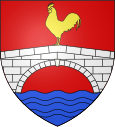Éloie
| Éloie | ||
|---|---|---|

|
|
|
| region | Bourgogne-Franche-Comté | |
| Department | Territoire de Belfort | |
| Arrondissement | Belfort | |
| Canton | Valdoie | |
| Community association | Grand Belfort | |
| Coordinates | 47 ° 41 ′ N , 6 ° 52 ′ E | |
| height | 384-490 m | |
| surface | 5.55 km 2 | |
| Residents | 948 (January 1, 2017) | |
| Population density | 171 inhabitants / km 2 | |
| Post Code | 90300 | |
| INSEE code | 90037 | |
| Website | Municipality of Éloie | |
 Mairie Éloie |
||
Éloie is a French commune in the department Territoire de Belfort in the region Bourgogne Franche-Comté .
geography
Éloie is located at 395 m above sea level, about six kilometers north of the city of Belfort (as the crow flies). The village extends in the foothills of the Vosges , on the southern edge of the Giromagny basin, which extends between the Vosges, the hills of the Forêt de Roppe and the Montagne de Salbert, in the plain on both sides of the Rosemontoise river .
The area of the 5.55 km² municipal area includes a section in the area of the Vosges foothills. The northern part of the area is occupied by the plain of the Giromagny basin, which lies at an average of 400 m. It is partly with arable land and meadow, partly with forest. The area is crossed by the Rosemontoise, which takes in the Verdoyeux from the left near the village . Along the rivers and in hollows there are numerous ponds that were once created for fish farming. To the north, the communal soil extends into the extensive forests of the Forêt de Vaivre and the Forêt de la Chaume . South of the village, the terrain gradually rises towards the hills of the Forêt de Roppe. This section is also predominantly forested. At 490 m, the highest elevation of Éloie is reached on Mont Rudolphe . In the far south-east the parish soil extends to the Étang Rudolphe at the foot of Fort de Roppe. Part of the area is designated as a military firing range.
Neighboring municipalities of Éloie are Chaux and Grosmagny in the north, Anjoutey and Roppe in the east, Vétrigne , Offemont and Valdoie in the south and Sermamagny in the west.
history
Éloie is first mentioned in a document in 1347. Initially under the influence of the Counts of Montbéliard , the village has always belonged to the dominion of Rosemont. This came under the sovereignty of the Habsburgs in the middle of the 14th century. Together with the Sundgau , Éloie came to the French crown with the Peace of Westphalia in 1648. Since 1793 the village has belonged to the Haut-Rhin department , but in 1871 it remained as part of the Territoire de Belfort, unlike the rest of Alsace, in France. Since 1976, Éloie has been a member of the Belfort agglomeration, which in 1999 became the Communauté d'Agglomération Belfortaine , which in turn became part of the Communauté d'agglomération Grand Belfort in 2017 .
The chapel of Éloie was built in 1957. It was prepared by the residents from a dilapidated barrack and is now also used as the community's event space.
Population development
| year | 1962 | 1968 | 1975 | 1982 | 1990 | 1999 | 2007 |
| Residents | 163 | 182 | 447 | 695 | 889 | 837 | 960 |
With 948 inhabitants (January 1, 2017), Éloie is one of the small communities in the Territoire de Belfort. After the population in the first half of the 20th century had always been in the range between 105 and 150 people, a strong population growth has been recorded since the beginning of the 1970s. Since then the number of inhabitants has increased sixfold.
Economy and Infrastructure
Until well into the 20th century, Éloie was a village dominated by agriculture (arable farming, fruit growing and cattle breeding), fish farming and forestry. Today there are some small and medium-sized businesses. In the meantime, the village has also turned into a residential community. Many workers are therefore commuters who go to work in the larger towns in the area and in the Belfort agglomeration.
The village is located away from the major thoroughfares on a departmental road that leads from Valdoie to Grosmagny. The closest connection to the A36 motorway is around nine kilometers away. Further road connections exist with Sermamagny, Rougegoutte and Étueffont. Éloie is connected to the city of Belfort by a bus line.
literature
- Le Patrimoine des Communes du Territoire de Belfort. Flohic Editions, Paris 1999, ISBN 2-84234-037-X , p. 217.

